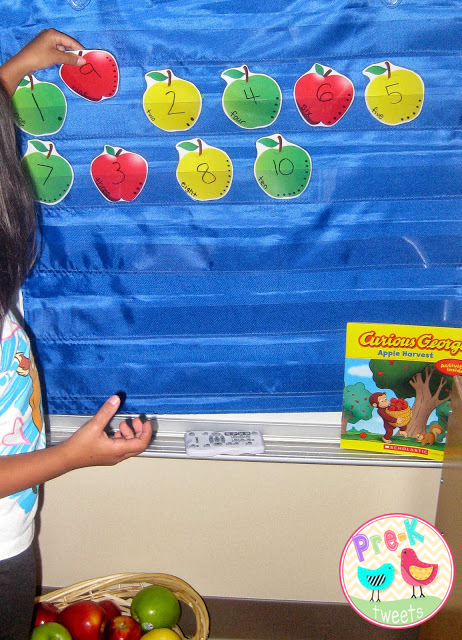Welcome back to the Pre-K Partner's Learning Centers Blog Hop Series! Every other Thursday (through November) we are highlighting unique learning center ideas. This week we are going to take a look at the math/manipulatives center!
I have always had a designated "math center" in my classroom. The math center is a fun and engaging area full of hands on games, math storybooks, and manipulatives.
This is a photo of my beginning of the year set-up for the math center. As you can see, it is pretty empty! That is because I have always introduced & integrated each and every math game/manipulative slowly into the center. These items should always be modeled and practiced before students do them independently. You will spend less time during centers teaching students how to do the games and more time observing/documenting learning! Also, when we have showcased new center games (during group carpet/circle time) it builds up excitement and students are eager to try out the new centers. (I've always rotated centers seasonally and with the topic of study we are learning about.)
The photo above was taken when centers were in full swing! Baskets and containers make it easy for students to collect, organize, and clean the center when finished. Because procedures were taught and reinforced so much, my assistant/nor I rarely had to ask students to straighten centers..believe it or not! The math center contained a variety of items including: board games, loose manipulatives, literature, vocabulary, and pocket chart games.
The photo above was taken during our spring unit! Activities included: a bird matching game, Grouchy Ladybug book with telling time clock, a bird path/dice game, tactile number tracer boards, a flower petal numeral matching folder game, a caterpillar dice drawing game, chick number counting eggs, caterpillar graphing game, loose flower/bug manipulatives for sorting and counting, and insect/spring themed counting books.
The math and/or manipulatives center helps students to practice math skills such as:
- counting
- patterning
- sorting
- graphing
- measuring
- less than/more than
- number order and sequencing
- number writing/identification
- color/shape recognition
- use new math vocabulary
The center also helps students to:
- build spatial awareness
- work on fine motor skills
- practice social skills
The math center environment and materials should include:
- a table or work space
- shelving with easy access of materials
- hands on games (games students can play alone, with a partner or in a small group)
- literature that relates to numbers, patterns, shapes, colors, math stories, etc.
- math vocab. (number cards, shape cards, number words)
- loose manipulatives (unifix cubes, pattern beads, pattern blocks, manipulative building toys) so students can freely count, stack, sort, and pattern with.
Other items you might consider:
- Plastic/wooden trays & cups/bowls for game storage
- Baskets for manipulative toys and books
- Spinners (made from q-tips and paperclips)
- Dice (large, small, and some with numerals and some with number dots)
- Game pieces that are fun & unique (sea shells, mini erasers, plastic acorns, fake leaves...)
- Board games that are geared for early childhood
(Check out Pre-K Tweets themed math games!)
- Plastic page protector sheets (for games so students can write on them with dry erase markers..great for when you don't have time to laminate...and you can store all your math games in a 3-ring binder)
The teacher's role during math/manipulatives center time (and during other center play) is to monitor, encourage, engage, observe, and document. Teachers should monitor behavior, social interactions, and game play/manip. procedures.
The teacher can encourage students to try out new activities. The teacher can engage students by providing a variety of fun games/manipulatives that reach students of varying skill levels. I've always tried to enhance my math center by having different games geared toward lower level, middle level, and higher level learners. I've also included a variety of games that include multiple math skills. (ex. a graphing game that includes rolling a dice, identifying number, counting, writing, etc.)
The teacher can use this center time to observe and document student learning of new math skills. Center time is a great opportunity to see student learning in action!
Stay tuned for more learning center fun during the Pre-K Partner's Learning Centers Blog Hop Series!
Hop on over to Fun in ECSE for more blocks learning center ideas!






































































